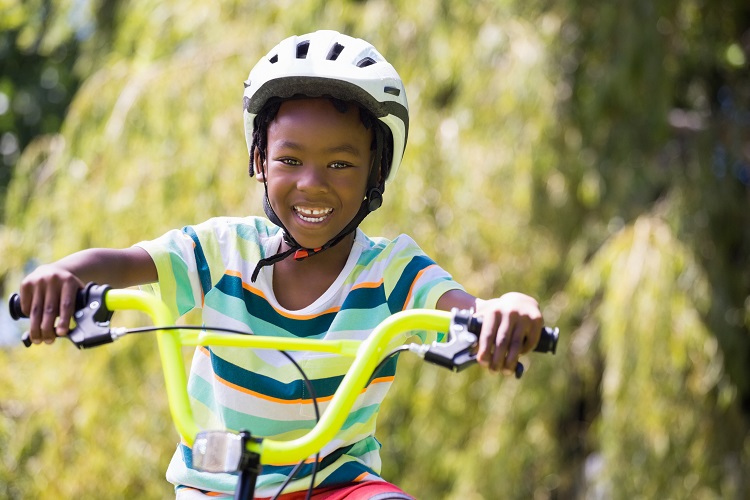
Whether used for transportation or just for fun, bikes can be a great way to get outdoors and get some exercise! When parents encourage their children to practice bike and helmet safety, they can help prevent some injuries that can occur while riding, such as concussions. Perhaps most importantly, both children and adults should always wear a helmet every time they ride a bike – even on short rides. While not all injuries can be prevented, a good-fitting helmet can provide protection to one’s face, skull, and brain if a fall occurs. But with so many options, finding the right helmet for your child may seem overwhelming.
Follow the guidelines below for some help!
- As helmets are so important, the U.S. government has created safety standards for them. When purchasing a helmet for your child, look for a sticker that says it meets the Consumer Product Safety Commission (CPSC) standards.
- Helmets should fit snugly all around, with no space between the foam and the rider’s head.
- The bottom of the pad inside the front of the helmet should be one or two finger widths above the rider’s eyebrows. The back should not touch the top of the rider’s neck.
- Make sure you can see your child’s eyes and that he or she can see straight forward and side-to-side.
- Side straps should make a “V” shape under and slightly in front of the rider’s ears.
- No more than one or two fingers should be able to fit under the chin strap. When your child opens his or her mouth wide, the helmet should pull down on their head. If it doesn’t, the chin strap needs to be tighter.
- The helmet should not move in any direction once the chin strap is fastened.
- If your helmet is damaged or has been through a crash, get a new one! Helmets are designed to help protect the rider from one serious impact.
Riding a bike that is in good condition and is the right size for your child can also help keep him or her safe! To quickly test a bike to see if it is the right size, have your child stand straddling the top bar of the bike with both feet are on the ground. There should be 1 to 3 inches of space between your child and the top bar. Also, always check that your child’s bike has brakes that work well and the tires have enough air.
Once your child has a helmet that fits and a bike that is the right size, he or she is ready to ride! Helping your child to understand and follow the following safety guidelines can help keep him or her safety while riding:
- Always ride with hands on the handlebars.
- Always stop and check for traffic in both directions when leaving your driveway, a curb, or an alley.
- Use bike lanes when possible, and always ride on the right side of the street, in the same direction as cars.
- Stop at all stop signs, obey traffic lights, and learn appropriate turning signals.
- Ride with friends in a single file line.
- Do not wear headphones while riding a bike. Music may distract the rider from noises, such as car horns.
References:
Centers for Disease Control. (2015). Get a heads up on bike helmet safety. Retrieved from
https://www.cdc.gov/headsup/pdfs/helmets/headsup_helmetfactsheet_bike_508.pdf
Kidshealth. (2014). Bike safety. Retrieved from http://kidshealth.org/en/kids/bike-safety.html



